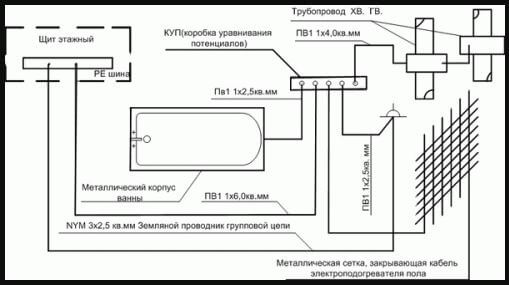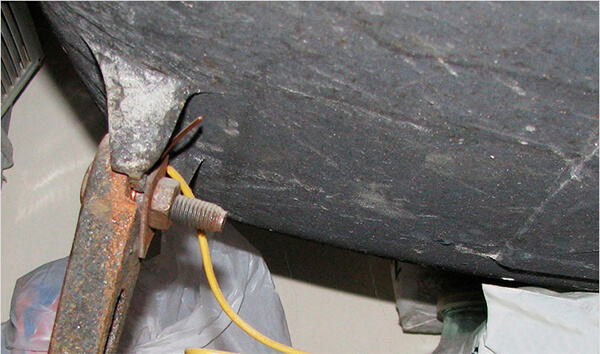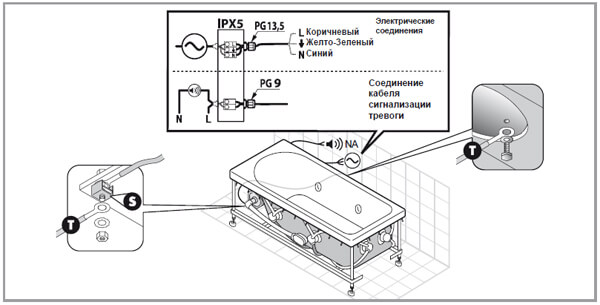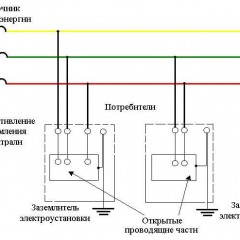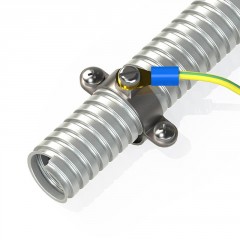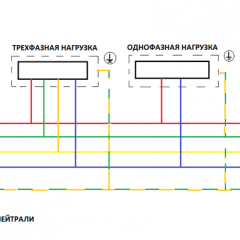How to ground a bathtub in an apartment if there is no grounding
PUE requirements
First of all, it is necessary to familiarize yourself with the requirements of the Electrical Installation Rules (PUE) regarding this issue. Clause 1.7.57. (cm. Chapter 1.7 of the EMP) prescribes the use of electrical networks with a grounded neutral (for voltages up to 1000 volts) and a TN earthing system for power supply of residential and public facilities. This means that power supply to single-phase consumers is carried out through a three-wire network:
- phase wire;
- working neutral wire;
- PE or PEN protective earth conductor.
As a protective measure of safety with indirect contact, the so-called basic potential equalization system. Its essence is as follows. It is necessary to make a connection between the following conductive parts:
- PE or PEN conductor, depending on whether the TN-C grounding system is used or TN-S.
- Re-earthing device, if present at the power input.
- Pipes (metal) of all communications. This applies to water supply systems (cold and hot), heating and sewer pipes, as well as gas supply pipes.
- Elements of the metal frame of the building.
- Metal structures for air conditioning and ventilation.
- Lightning protection grounding device.
- Shielding for telecommunication cables.
In addition, as part of an additional equalization of potentials (clause 1.7.83.), All open conductive parts of electrical equipment are connected to PE or PEN conductors, as well as third-party conductive structures, including a metal bath that needs to be grounded. Next, we will dwell on how to do the earthing of the bathtub in the apartment with your own hands.
Grounding Rules
In order to make the grounding of a metal (steel or cast-iron) bathtub in an apartment, in accordance with the requirements of the PUE (clause 1.7.57, clause 1.7.83), it is necessary to make connections according to the attached diagram:
In order to ground all metal parts in the bathroom, you must first install the potential equalization box. You can make it from any terminal or junction box containing a zero bus with the required number of terminals. The box is connected to a PE or PEN bus located in the entry or floor plate. Next, make the connection to the potential equalization box of the following metal parts (essentially ground them):
- metal bath body;
- pipelines of hot and cold water supply;
- shielding net covering the heating floor heating cable, if any.
Typically, the design of metal bathtubs contain special contact elements for attaching a ground wire to them. The cross-section of the wire for grounding the bathtub must be at least 2.5 mm2 For these purposes, you can choose a brand wire PV-1. In the absence of such a contact, you can make it yourself: weld a bolt in the lower part of the housing, for subsequent mounting of the grounding conductor under the nut. For this purpose, it is better to use a tide on the case, designed to install a removable leg. The photo below clearly shows how to ground a cast-iron bathtub in an apartment:
If the bathtub is acrylic, you can ground it using a metal frame on which the bowl is mounted. Despite the fact that acrylic is a dielectric, it is still able to glow static electricityas a result of which it is possible to get an electric shock from the bath. Organization of protection will make it possible to protect against this.
In addition, electrical outlets located in the bathroom (as in other rooms) must have three contacts, with a PE or PEN conductor connected.
Grounding a bathtub with hydromassage is not fundamentally different from grounding of a conventional design. The jacuzzi is equipped with electric pumps, the body of which should be grounded, connecting it with a protective grounding conductor. The Jacuzzi grounding scheme is presented below:
It should be added to the above that, in accordance with paragraphs 701.415.1, 701.415.2 of GOST R 50571.7.701-2013, the installation of electrical outlets in the bathroom in the apartment is allowed subject to one of two conditions:
- the socket is connected to the network through an isolation transformer, providing galvanic isolation;
- socket protected residual current device (RCD), with a differential current setpoint, not more than 30 mA.
When reading the PUE, the natural question arises: how to properly ground the bathtub in an apartment located in an old house, for example, in Khrushchev, where there is no protective grounding conductor? Is the event obligatory or not? In this case, it is necessary to bring the grounding system in accordance with the PUE, that is, switch to the TN system. There can be no other answer to this question.
Caution home masters from unskilled actions in this direction. In systems without protective grounding, the bath should not be connected to pipes for water supply, heating or to self-made grounding. Please note that the system of measures aimed at ensuring safety, in particular, in the bathroom, is indicated in the EMP as "potential equalization system", and not "grounding". Therein lies a deep meaning, expressed in the fact that the end in itself is not grounding, but the prevention of the possibility of a person falling under the influence of a difference in electric potentials.
The potential equalization system, as a means of protection, loses its effectiveness after the use of (at least even episodic) conduits with plastic pipes. In this situation, correctly installed and sensitively configured residual current device will help protect against accident. About, how to connect an RCD to the network, we told in a separate article.
In the video below, you can also see the expert opinion on how to organize the grounding of the bathtub in an apartment or private house:
This is all we wanted to tell you about how to do the earthing of the bathtub in the apartment with our own hands. Take into account the requirements of the PUE and our recommendations to ground the structure correctly and be safe!
Surely you do not know:

